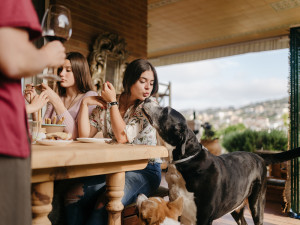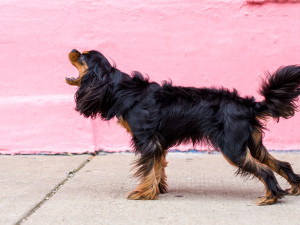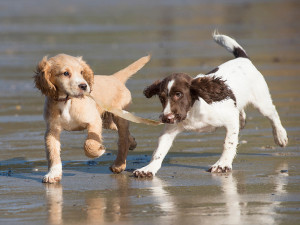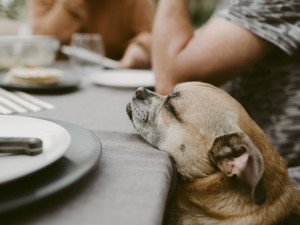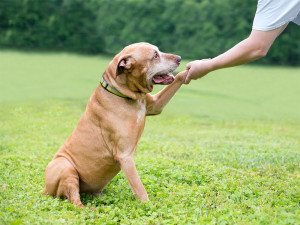How to Keep Your Dog From Freaking Out When You Have Company
Do these things to help your pup (and your guests) feel chill.

Share Article
If your dog gets upset when you have people over, you’re not alone. I get calls every week from people who want help with dogs who react badly to anyone who comes into the house. More often than not, these dogs are afraid — but people rarely call to say that they have a fearful dog. They call to tell me that their dogs are aggressive towards visitors by barking, lunging, growling, or even biting people.
Comprehensive dog training programs for improving a dog’s emotional state and behavior when visitors arrive must be individually designed for each dog and each situation. Often, the use of treats or favorite toys is involved so that the dog learns that all visitors have something fun and wonderful to offer. When a dog has grasped the strong connection between visitors and good things, happiness can replace fear as the dog’s response to people coming to the house. That’s a very brief and simplified description of what can often be a long and detailed process. Sometimes one simple trick can help. Keep reading to learn what it is and how to try it.
How to Help a Fearful Dog Handle Visitors
Don’t let your dog see a guest enter your home.
The trick is to make sure your dog doesn’t see the visitors when they enter. Instead, you want your dog to encounter the guest when they are already settled in the house. It’s a lot easier for a dog to see people already seated in the living room or around the table than it is for them to see people arrive and enter. Having visitors show up at the door is a very intense situation for a fearful dog. The sight, smell, and sound of someone other than a family member appearing at the door and entering the home is a big deal to a dog who is not comfortable with new people. It sets off all of their alarm bells (“Intruder!”).
To avoid that, tell your visitors to call or text right before coming in so you can make sure you have the situation set up to maximize your chances of success. Before opening the door for your visitors, temporarily put your dog in a place out of sight of the entry, such as in a crate in another room, in the backyard, or in the laundry room. I’ve even had clients briefly put their dog in the car in the garage if that is where the dog is most comfortable when not with their humans.
How much do you spend on your pet per year?

Give your guest treats to earn your dog’s affection.
Once your dog is where you want them, let your visitors in, have them sit down, and give them whatever treats or toys your dog loves best. Then, bring your dog into the room and have them give your dog the goodies. Depending on the details of the dog’s issues, you may need to have your dog on a leash or behind a gate during this interaction.
If your dog (or your guest) is uncomfortable, keep your pet separate from them.
Some dogs will be fine with people once they have met them in this way, and if that’s the case, then this may be all you have to do during this particular visit. Other dogs may react poorly if anyone stands up or makes any sudden movements, so it may be better to keep them separate from your visitors after the initial exposure. Such dogs can benefit from additional work, but this technique can still be a good first step.
No single method suits every dog, and extra caution is always advisable with dogs who have bitten someone. Still, it is easier for almost all fearful dogs to meet visitors who are already in the house sitting down than it is to meet people as they enter the house. It will take time and patience for your dog to learn this skill. Like everything with dog training, there is no quick fix. But, with the help of a friend or two, a handful of treats, and a little patience, you can help ease your dog’s fear of household visitors.

Karen B. London, PhD, CAAB, CPDT-KA
Karen B. London is a certified applied animal behaviorist (CAAB) and certified professional dog trainer (CPDT) who specializes in working with dogs with serious behavioral issues, including aggression. She has written for a variety of magazines including The Bark, Clean Run, and the APDT Chronicle of the Dog, and has published in scientific journals including Behavioral Ecology and Sociobiology, Ethology, Ecology, and Evolution, the Journal of Insect Behavior, and Insectes Sociaux. She is the author of seven books about dog training and canine behavior, including the forthcoming My Dog's Mystery Adventure: And Other Stories From a Canine Behaviorist and Dog Trainer.
Related articles
![Woman Feeding Her Dog During Dinner]()
How to Train Your Dog in Social Graces
Because nobody wants your pup eating the host’s charcuterie platter.
![Pet parent comforting anxious dog by holding their paw]()
How to Help an Anxious Dog
Easy ways to calm your pup’s nerves.
![A dog resting its face on a dinner table.]()
5 Tips for Keeping Your Dog Out of Trouble This Thanksgiving
Because your pup is not too proud to beg.
![Russian Toy Terrier with ears back]()
9 Reasons Why Dogs Put Their Ears Back
Here’s how your dog’s ears can clue you in to how they’re feeling.
![puppy jumping up on crate]()
Gimme Shelter: The Best Dog Crates
Spend less time searching for your dog’s house than you do on Zillow.
![A senior Retriever/Terrier mixed breed dog shaking hands with its owner.]()
How to Teach an Old Dog New Tricks
Your senior dog might move slower these days, but that doesn’t mean they can’t learn new things.
